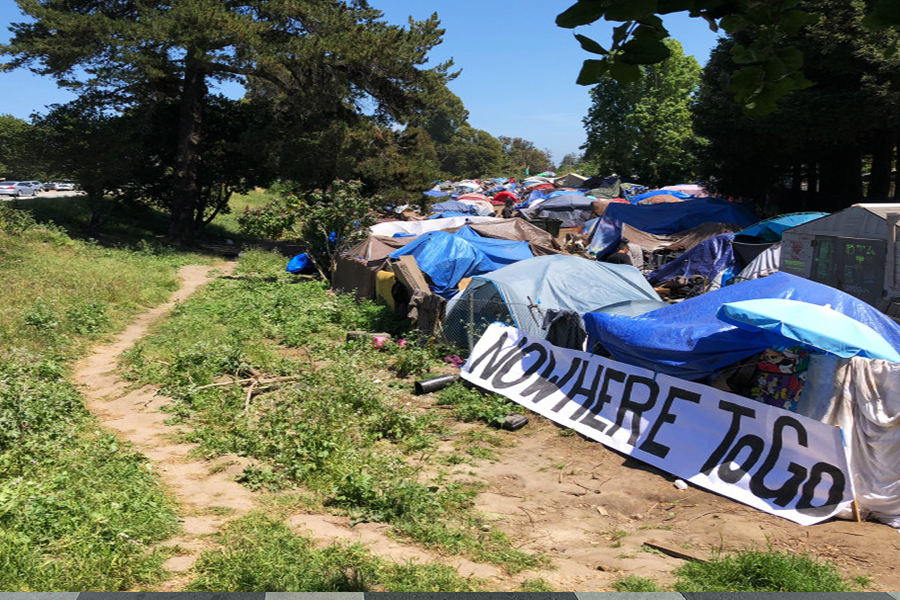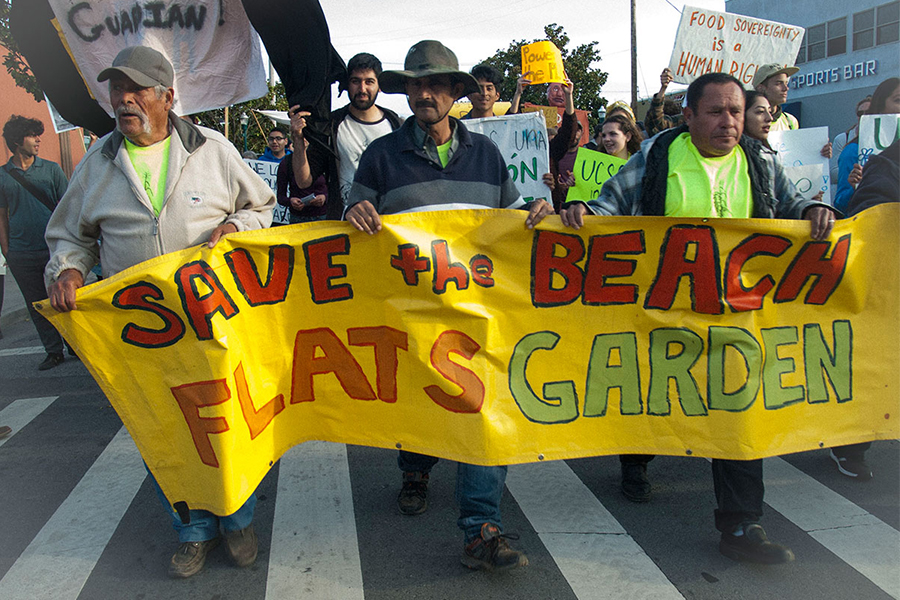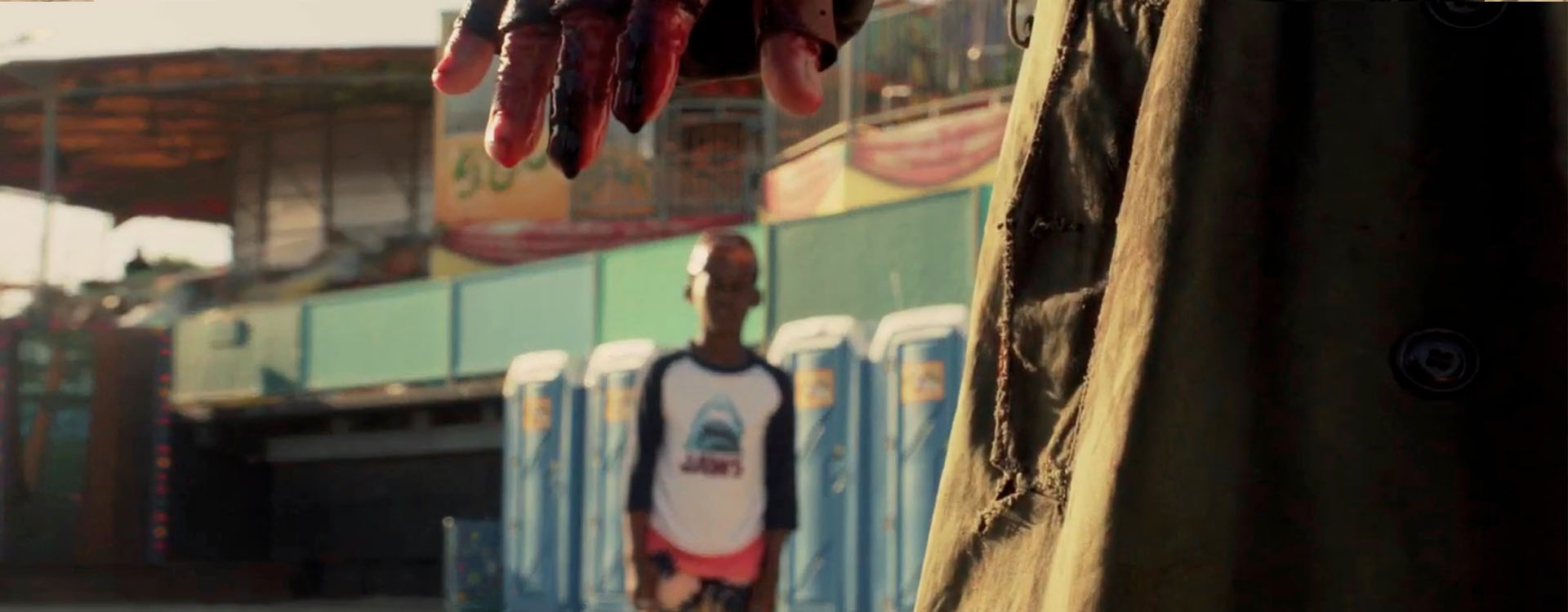In Jordan Peele’s Us, the real Santa Cruz ascends from its hidden places.
Santa Cruz, the beachside hippie town where the first of Ken Kesey’s acid tests took place, imagines itself the frontier of creativity and freedom. With its mélange of alternative lifestyles and intellectual freedoms, today’s Santa Cruz, the “City on a Hill,” never ceases to display its bohemian bona fides. However, this countercultural creativity masks a regime of escalating precarity and oppression. The new capitalism of Silicon Valley, only dozens of miles away, did not merely roll back the political gains of the sixties, but, body-snatcher style, absorbed its values. Fantasies of countercultural liberation allow Santa Cruzans the faux-innocence of H.G. Wells’s Eloi, who live beautiful lives above the surface while Morlock troglodytes labor below. What better place, then, to explore, as Jordan Peele does in Us, the violence of the quite-literal underclasses as they rise up against their willfully ignorant oppressors?
The same day I saw Us in Santa Cruz’s Cinema 9 theater, I made my weekly trek to what has come to be called the Ross Camp, after its location behind Ross: Dress for Less. The camp shelters about two hundred unhoused people. Since our group has been bringing supplies to the camp in the spirit of mutual aid, we have seen a few others trying to help out, usually people from Watsonville and members of African-American churches. But mostly, I see white Santa Cruzans riding their expensive bikes on the path adjacent to the camp. Later, I will read their infuriated letters to the Santa Cruz Sentinel about the homeless plague, or my friends will recount to me the indignant comments made by these people on Nextdoor, the social network property owners use to police and surveil neighborhoods.

In the first few minutes of the film we see the protagonist, Adelaide, at the Santa Cruz Boardwalk, trailing her bickering parents while blithe tourists stream past. The mother suggests Adelaide might be hired as an extra for a film being shot at the boardwalk (an homage to the 1987 Santa Cruz classic The Lost Boys). As if hypnotized, Adelaide then wanders away into an attraction located under the boardwalk, the Shaman’s Vision Quest Forest. After passing through a kitschy pastiche of Native American ornaments, she has a haunting encounter that will change the course of her life.
Decades later, she reluctantly returns to the Santa Cruz beach with her own family to vacation with friends. Her childhood terrors are recalled when she briefly loses track of her son, Jason. Later, after the whole family is attacked by their doppelgängers, they attempt to escape town but face a flaming barricade erected by Jason’s doppelgänger, Pluto. After Jason is kidnapped by Adelaide’s double, Red, Adelaide is forced to descend once again into the shadow world she encountered in 1986. Meanwhile, on the beach, we see a line of underground-dwelling doppelgängers, called “the tethered,” wearing red jumpsuits and holding hands. They stand perfectly still but carry sharp gold scissors that will lead to further carnage and a revolution they call “the Untethering.”
After the film came out, a spate of articles in the local press worried that viewers would be scared off from Santa Cruz. I hope they are—not because of spooky zombies in jumpsuits, but because Santa Cruz’s sharing economy of Uber drivers and Airbnb condos is driving thousands of residents underground. As a friend wrote to the city council on the eve of their vote to evict the Ross Camp, leaving hundreds without a place to lay their heads, “I see the causes of displacement daily: gentrification, insane rents, low wages. Every day I greet former neighbors living in their cars or on the streets.” Beautiful, relaxed, enlightened Santa Cruz is a wolf in sheep’s clothing, Peter Thiel in hippie garb. Skeptic philosopher Jean Baudrillard noted, in his expansive way, that Santa Cruz was not only an exemplary hippie beach town, but a symbol of America more broadly: a place where the dreams of the sixties congealed into individualist greed with adorned with a dollop of New Age enlightenment.
Every detail of Us is lovingly—one could say curatorially—chosen. If some filmic details are changed (Amazon’s Alexa is renamed Ophelia, for example), the site of Adelaide’s trauma is clearly named. As the family enters the town, Adelaide’s husband Gabe chants, “Santa Cruz, Santa Cruz.” We are never allowed to forget where we are.
“Yesterday in the local coffee shop I saw a flyer encouraging the self-organization of students living in their cars. Perhaps I swapped lives with one of them—stole her apartment, stole her life?”
This choice does much for Peele, summoning the run-down resort setting of The Shining. The depiction of Santa Cruz’s blasé culture (telegraphed in the figure of the tattooed hipster, Josh Tyler, played by Tim Heidecker) continues the exploration of white liberalism begun in Get Out. The carnival or boardwalk is an enduring trope in horror, a place of racial and class mixing amidst dysphoric dreamscapes, from Freaks (1932) through Carnival of Souls (1962) to American Horror Story: Freak Show (2014). Most importantly, Santa Cruz is proof that the colonization of minds and bodies endures in the least expected places. Santa Cruz is not a counterintuitive place to find horror; it is the logical epicenter of global capitalism’s emergent neocolonialist forms. This is why the view of violence one encounters in the work of Frantz Fanon—thought to be a relic of the bad old days—is so overtly on display in Us. And why it feels so relevant.
In “On Violence,” Fanon writes, “decolonization is always a violent event . . . . decolonization is quite simply the substitution of one ‘species’ of mankind by another.” The antagonists in the struggle for freedom are defined by adversity, but they are also tethered to each other in a fatal combat for recognition and domination, like Hegel’s master and bondsman. Only revolution can cut through these chains, after which “The last shall be the first.” Like most horror monsters, the tethered can be viewed as evil, but from another angle their revolt is justified: they suffer misery so their masters can play in the sunshine. The “evil” of the tethered, then, is only evil from the colonizers’ point of view. They follow a long legacy of horror imagery that renders strange the dehumanization of the oppressed in order that it become visible.
As Jesse, an undocumented woman at Ross Camp, said to me of the Santa Cruz media and officials alike, “They treat us like animals. They talk about us like we are animals.” At a Santa Cruz screening of films meant to bring to light the dire need for rent control, an interloper distributed flyers featuring racist images of Latino “gangsters” who would overtake the area, should renter protections pass. For years, the Seaside Company, which owns the Santa Cruz Boardwalk, has been in the process of evicting the Beach Flats Community Garden—an oasis in which low-income Latino residents raise indigenous fruits and vegetables, supplementing their diet and preserving cultural traditions. Periodic ICE raids rampage through Santa Cruz’s Latino neighborhoods, leaving fear and broken families in their wake. The median price to rent a modest apartment in Santa Cruz is three-thousand dollars. Small, run-down one-bedrooms sell for a million. As Silicon Valley encroaches, more and more people find themselves sleeping in tents, in cars, under bridges. Like the tethered, they are condemned to lurk below, increasingly policed and incarcerated through technologies like PredPol, a Silicon Valley “innovation” of supposedly race-blind algorithmic policing developed in Santa Cruz. Leave it to the sun-kissed center of human flourishing to cement carceral capitalism in the name of anti-racism, then export this sanitized policing to the nation.

In Us, the tethered wear red jumpsuits that could be prison uniforms and sleep in dormitories that could be prison quarters. Images of shackles evoke legacies of slavery, with Red’s nonconsensual “marriage” and subsequent childbearing connoting rape and forced reproduction under slavery. And yet, in the aboveground world, there is no sign of racist criminalization. When confronted by their menacing doppelgängers, the African-American Wilsons don’t hesitate to call the police. Unlike Chris Washington in Get Out, they never have to reckon with the fear of police violence; that threat is displaced onto their doubles. Rather, at one point they are identified with the cops. The image of a car serving as burning barricade is typically associated with the context of an anti-racist riot; in Us, it is the Wilsons’ car that is burned in this fashion, situating the family as cop-surrogates. As their suburban family vehicle falls to the riot, they are complicit in killing one of the rioters. Pluto, Jason’s doppelgänger, shows trust in Jason because they look the same, yet Jason lures him into the flames—and it is implied that Jason may also be responsible for an earlier incident in which Pluto’s face was disfigured by burns.
This complicated intersection of race and class stands in strange relation to the largely whiter-than-white town of Santa Cruz, where race and class are so often congruent. Gender, also, one might suggest, does not figure in the film’s central drama—or the town’s. Given that three-quarters of the city came out for the 2017 Women’s March, Santa Cruz might seem unimpeachable in its feminism. This is only so, however, if we refuse to look beyond the vast sea of pussyhats to the immiserated labor of the beachside town’s feminized workforce—sex workers, cleaners, teachers who live in their vehicles or are one paycheck away from losing their housing.
My partner and I are the lucky ones: we attained full-time academic jobs, but still live precariously with little prospect of home ownership. To be housed at all we had to outbid students on a small, outrageously overpriced rental. It is cozy and near the beach (I fall asleep listening to the muted screams of roller coaster riders, oddly soothing), but its pleasures demand repressing the feeling that one person’s enjoyment is another’s loss. Yesterday in the local coffee shop I saw a flyer encouraging the self-organization of students living in their cars. Perhaps I swapped lives with one of them—stole her apartment, stole her life?
Hired as extras, some of the casualties of Santa Cruz’s economy end up onscreen. A graduate student friend of mine played a corpse on the beach. As the action unfolds in the foreground, she lies there, crumpled and unmoving. A couple of months after her scene was shot, she moved to Mexico City, pushed out by the struggle to survive. She followed the exit route that nearly all of my friends from graduate school have taken, leaving for unknown prospects of intellectual community and stability.
Santa Cruz is a paradise, but it is not a place apart from Us or the US. It is the American Dream writ small, made carnivalesque, dotted with palm trees and brightly colored beach towels. And it hosts a growing underground colony of people who, deprived of the abundant sunshine and fresh air that is everywhere and yet out of reach, are ready for the Untethering.





